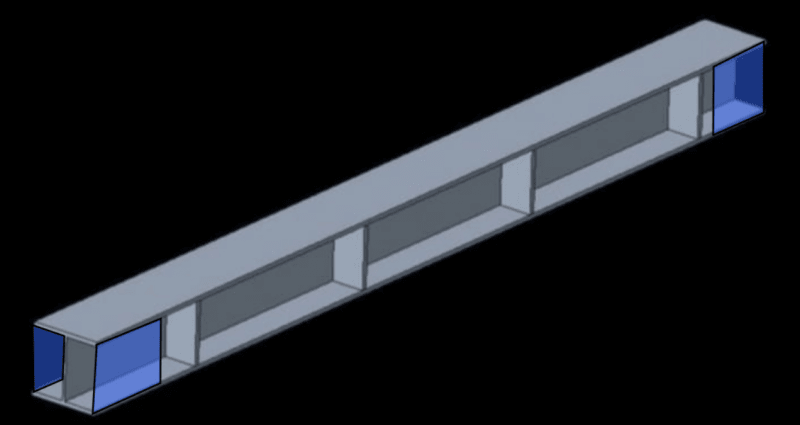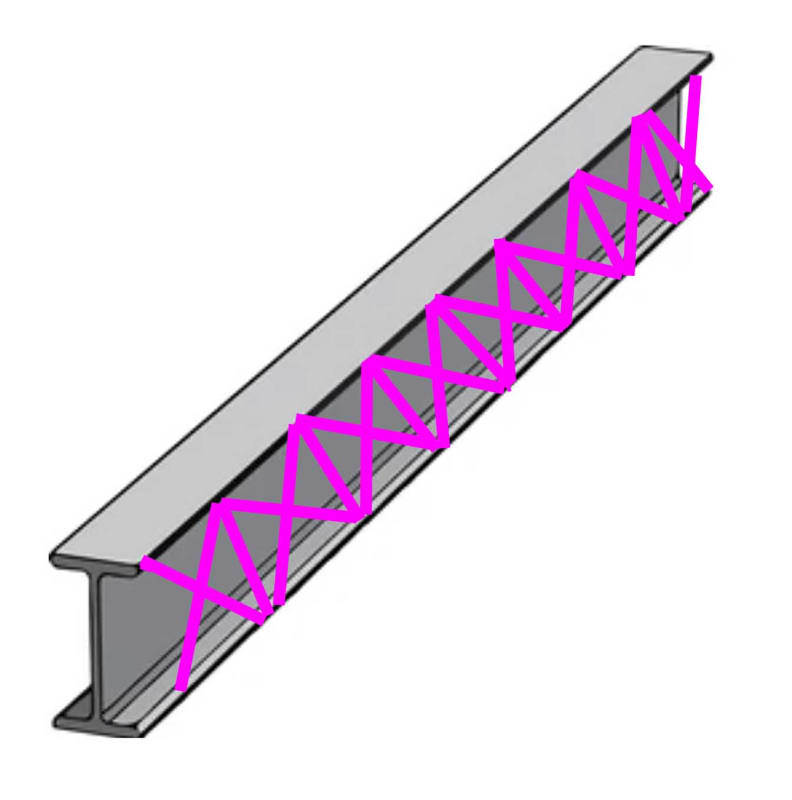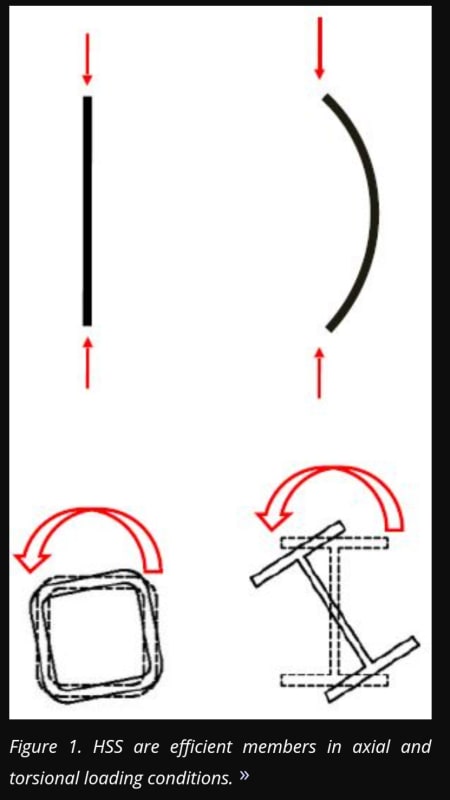Navigation
Install the app
How to install the app on iOS
Follow along with the video below to see how to install our site as a web app on your home screen.
Note: This feature may not be available in some browsers.
More options
Style variation
-
Congratulations TugboatEng on being selected by the Eng-Tips community for having the most helpful posts in the forums last week. Way to Go!
You are using an out of date browser. It may not display this or other websites correctly.
You should upgrade or use an alternative browser.
You should upgrade or use an alternative browser.
Wide flange with stiffener plates against Torsion? 8
- Thread starter planc
- Start date
- Status
- Not open for further replies.
- Thread starter
- #3
You can box in the wide flange on both or one side of the beam. Run a plate full length on the beam (or in the length where you see torsion) from the top flange to the bottom flange to make a box section. Then you still need to get the torsion out at the ends.
While stiffeners as drawn likely don't do much, if anything, to reduce the torsional stress, I suspect they probably help with deflection to some degree by resetting the warping of the section at those points. I don't think I've seen any studies anywhere that would tell you how to quantify it, but a fancy FEA might be able to. I would not at all suggest doing this, but I'd be interested in what that looked like, personally.
While stiffeners as drawn likely don't do much, if anything, to reduce the torsional stress, I suspect they probably help with deflection to some degree by resetting the warping of the section at those points. I don't think I've seen any studies anywhere that would tell you how to quantify it, but a fancy FEA might be able to. I would not at all suggest doing this, but I'd be interested in what that looked like, personally.
I would be reluctant to use an open section such as a wide flange to resist anything more than nominal torsion. If torsion is self limiting as it is with joists framing into the beam, torsion is not usually considered at all. With large torsional load, vertical plates enclosing the section are good, but it may be more economical to use a hollow section or a pair of connected channels, separated by a gap.
BA
BA
-
2
- #8
I summon WArose to this thread!! Hopefully that works. Some time ago, he and I had an extensive debate on this topic. During the course of that discussion, WArose posted the results of some detailed FEM work that he did to study the effect of transverse stiffeners on a torsionally loaded wide flange beam. But, alas, I'm able to dig that up and share it here. The results:
1) Yeah, transverse stiffeners are mostly useless for torsion.
2) At a tight spacing, transverse stiffeners are indeed a bit useful.
As TLHS suggested, the stiffeners offer a form of intermittent, partial, warping restraint. I've come to view that kind of as if the stiffeners formed a pair of vierendeel trusses offset from the beam web.
1) Yeah, transverse stiffeners are mostly useless for torsion.
2) At a tight spacing, transverse stiffeners are indeed a bit useful.
As TLHS suggested, the stiffeners offer a form of intermittent, partial, warping restraint. I've come to view that kind of as if the stiffeners formed a pair of vierendeel trusses offset from the beam web.
-
1
- #9
planc said:Where to put the stiffeners plates than for restrain against torsion?
Side plates as shown below will help promote a condition of torsional fixity at the beams ends. And that can have a significant effect in decreasing twist. This won't, however, do much to alleviate torsional stresses along the span of the beam.

In fun thought experiment land where things are completely uneconomical and impractical, I suspect there's a stiffener spacing where they do start to help reasonably with torsion (at somewhere in the range of 0.5 to 2 times the lesser of beam width or depth?), where you've started to significantly restrain against warping distortions and you've got some sort of tension/compressive strut load path between successive stiffeners through the flange and some sort of shear wall type action in the other plane from the stiffeners. It would potentially start acting like a spaceframe truss.
I'd need to draw this out to figure out where exactly the stresses are going though, so I'm not going to outright state that it increases the capacity and not just the stiffness. I can't say I have a great mental picture of what an ultimate torsional shear failure would look like geometrically in this situation. It feels like it could fundamentally change the shear flow diagram, though, and therefore the behavior of St Venant's torsion. You have the shear doing a bigger circle around the stiffeners and then being transferred between stiffeners through struts forming in the flange (with an axial tie).
It feels like close enough stiffeners might give you a load path to use a couple between the top and bottom flange instead of the garbage couple in st venant's torsion that's effectively between opposite sides of the plate, and the stiffeners give you periodic shear flow between the top and bottom flange to let that happen (i.e. they give you a stiff load path that lets the top and bottom flanges work as a combined section against torsion. Picture it spiraling as it goes up the edge of the stiffener, diagonally across the flange to the next stiffener and then down the next stiffener)
I am very open to being told I'm missing something here. Can't say I've been fully rigorous by any stretch of the imagination.
Anyway, don't do this. It's ridiculous.
I'd need to draw this out to figure out where exactly the stresses are going though, so I'm not going to outright state that it increases the capacity and not just the stiffness. I can't say I have a great mental picture of what an ultimate torsional shear failure would look like geometrically in this situation. It feels like it could fundamentally change the shear flow diagram, though, and therefore the behavior of St Venant's torsion. You have the shear doing a bigger circle around the stiffeners and then being transferred between stiffeners through struts forming in the flange (with an axial tie).
It feels like close enough stiffeners might give you a load path to use a couple between the top and bottom flange instead of the garbage couple in st venant's torsion that's effectively between opposite sides of the plate, and the stiffeners give you periodic shear flow between the top and bottom flange to let that happen (i.e. they give you a stiff load path that lets the top and bottom flanges work as a combined section against torsion. Picture it spiraling as it goes up the edge of the stiffener, diagonally across the flange to the next stiffener and then down the next stiffener)
I am very open to being told I'm missing something here. Can't say I've been fully rigorous by any stretch of the imagination.
Anyway, don't do this. It's ridiculous.
That is correct. In fact this was something I examined just a couple of weeks ago in a real design problem. The design problem arose from a mistake that I made in oversight and resulted in damaged machinery. [flush]TLHS said:In fun thought experiment land where things are completely uneconomical and impractical, I suspect there's a stiffener spacing where they do start to help reasonably with torsion (at somewhere in the range of 0.5 to 2 times the lesser of beam width or depth?), where you've started to significantly restrain against warping distortions and you've got some sort of tension/compressive strut load path between successive stiffeners through the flange and some sort of shear wall type action in the other plane from the stiffeners. It would potentially start acting like a spaceframe truss.
A built up shedder member was designed by another and then checked for deflection and then approved with a couple extra stiffener gussets. Weeks later it turned out the member had deflected and got caught in some machinery. Not great, not the end of the world. The issue was obvious on physical examination. I got the original engineer to remodel the member with uneven pressures which produced the obvious result. The member was useless in torsion and torsion could result when it was unevenly loaded.
Going back to the stiffener spacing. From memory significant increase in stiffness was observed around 1-2 times member depth. I'm sure you could graph it with some sort of polynomial relationship.
- Thread starter
- #13
Plates need to go on the outside, ie parallel with web, ie close the section.
Do all others agree the description above by Tomfh about strengthening the steel beam against torsion by literally welding a whole one piece plate parallel with web on the outside and close the section? The thickness of the whole one piece plate will be same thickness as the flange. Will this create same torsion strength as hollow section of the same size (if both sides would be whole plated closing them)?
In torsion of I-beam. Is it due to the thinner web that is why the top flange can rotate downward or is due to the boundary between top flange and web that makes it want to rotate?
-
1
- #14
Yes. This is essentially the best solution to retrofit the beam. And yes if you use the same thickness as the flange it will essentially give you the same torsional stiffness as a hollow section of that depth. (Though depending on you torsion requirements you might be able to get by with thinner plate or even some plate staggering.)planc said:Do all others agree the description above by Tomfh about strengthening the steel beam against torsion by literally welding a whole one piece plate parallel with web on the outside and close the section? The thickness of the whole one piece plate will be same thickness as the flange. Will this create same torsion strength as hollow section of the same size (if both sides would be whole plated closing them)?
I'd suggest that other commenters haven't jumped in to reiterate this idea because it is clearly the best solution and doesn't need further elaboration.
Many ways to explain this. I'll try. In a similar manner to beams where bending is resisted by have a tension and compression side separated by some distance. Where the greater the distance the great the resistance. Torsion is resisted a loop of shear separated by some distance. And I-Beam has forces this loop trough web with very little distance between the loop paths. Circular or square hollow section doesn't have this issue.planc said:In torsion of I-beam. Is it due to the thinner web that is why the top flange can rotate downward or is due to the boundary between top flange and web that makes it want to rotate?
- Thread starter
- #15
planc,
Without getting in to how stiff do you need to make those members in order to get them to behave as you want (I'll save that for WARose and KootK and any others who enjoy digging into those rabbit holes), my first thought it is: Lord have mercy on the poor field welder who's going to install all that.
Also note, you may end up not getting full capacity of your truss elements, depending on what your flange thickness is.
Without getting in to how stiff do you need to make those members in order to get them to behave as you want (I'll save that for WARose and KootK and any others who enjoy digging into those rabbit holes), my first thought it is: Lord have mercy on the poor field welder who's going to install all that.
Also note, you may end up not getting full capacity of your truss elements, depending on what your flange thickness is.
I think it is about time that you go do your own research and calculations to get a solution you are confident in. Otherwise ask somebody in your organisation or hand off the problem to somebody else.planc said:What would happen if you used trusses on the sides made of angle bars instead of whole one piece plate? It's very difficult to transport whole plates.
What you are proposing seems less practical. If whole plates are difficult transport then cut them up. Either way you'll still come back to having to calculate the torsion capacity of the member yourself rather than just throwing out ideas to the ENG-TIPS community and seeing what sticks.
- Thread starter
- #18
-
1
- #20
I summon WArose to this thread!! Hopefully that works. Some time ago, he and I had an extensive debate on this topic. During the course of that discussion, WArose posted the results of some detailed FEM work that he did to study the effect of transverse stiffeners on a torsionally loaded wide flange beam. But, alas, I'm able to dig that up and share it here....
Looks like I'm late to the party.
![[smile] [smile] [smile]](/data/assets/smilies/smile.gif) But yes: stiffeners are pretty much useless for restraining torsion. The only reason I got into it is because I had a beam subjected to 100-200 ft-kips of torsion. (Special order wide flanges.) And I was wondering about the weld of the various stiffeners to the beam. (I.e. what force they would have to resist because of the torsion.) Turns out my worries were not justified....because the stiffeners didn't do anything as far as torsion goes. (Not without ridiculous spacing.)
But yes: stiffeners are pretty much useless for restraining torsion. The only reason I got into it is because I had a beam subjected to 100-200 ft-kips of torsion. (Special order wide flanges.) And I was wondering about the weld of the various stiffeners to the beam. (I.e. what force they would have to resist because of the torsion.) Turns out my worries were not justified....because the stiffeners didn't do anything as far as torsion goes. (Not without ridiculous spacing.)- Status
- Not open for further replies.
Similar threads
- Locked
- Question
- Replies
- 8
- Views
- 3K
- Replies
- 13
- Views
- 12K
- Locked
- Question
- Replies
- 7
- Views
- 1K
- Replies
- 10
- Views
- 992
- Replies
- 5
- Views
- 2K



